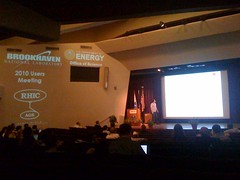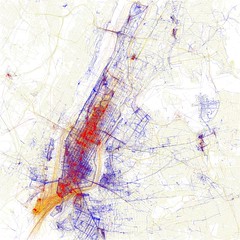
One of my least-well-kept secrets is that I'm mildly obsessed with the old hydrodynamical model invented by Landau and Fermi in the early 50's, which predicts (surprisingly well, IMHO) the total number of particles produced in collisions of nuclei, and even collisions of protons (and angular distributions, and some novel features of the same etc.). The physics is simple (pack all the energy into a tiny volume and let it explode along the beampipe) but the justification is downright bizarre (that all of these microscopic systems form a droplet of fluid as soon as they overlap each other). Of course, RHIC has told us that nuclei seem to form a fluid, and pretty damn quickly -- I'm still looking for a good reason why protons couldn't in principle do the same thing. Of course, making a snappy prediction would help my case.
So the points are nucleus-nucleus data (top trend) and proton-proton data (bottom-trend), and I've tried my hand at extrapolating with a few favorite functions. Unfortunately for me, but congratulations to CMS, the top one (my favorite) is pretty clearly ruled out by the low multiplicity measured by CMS today (4.5 instead of 5.5).
Of course, there are two more experiments to go, and a few more energies to be filled in in the next few years. A man can still dream -- especially since the CMS paper measures the number of particles at 90 degrees relative to the colliding beams, which is *not* the same thing as the total number. Of course, the calculations nominally allow one to predict things at 90 degrees but lots of things can get in the way. No-one said this would be easy!












